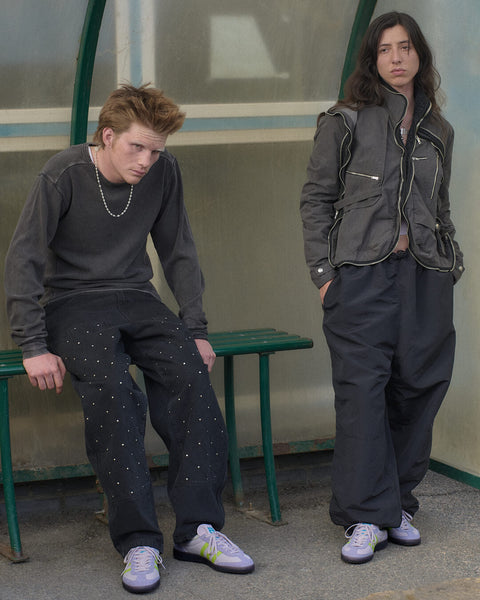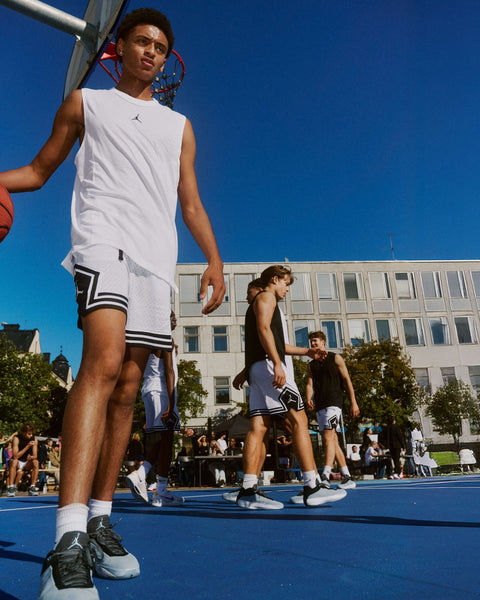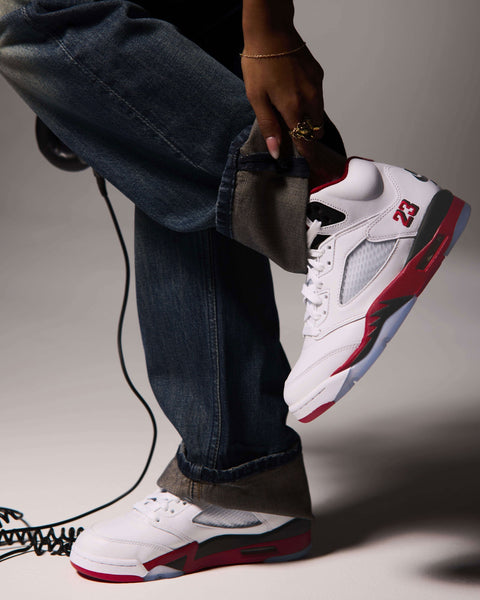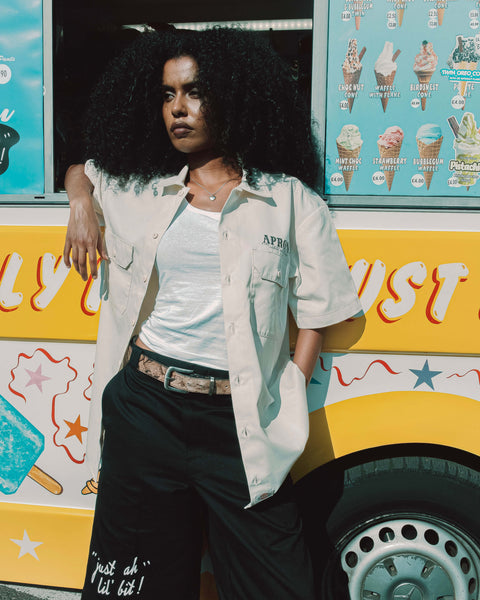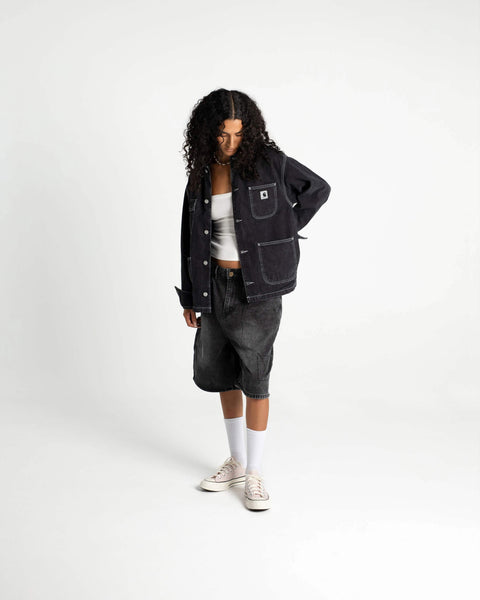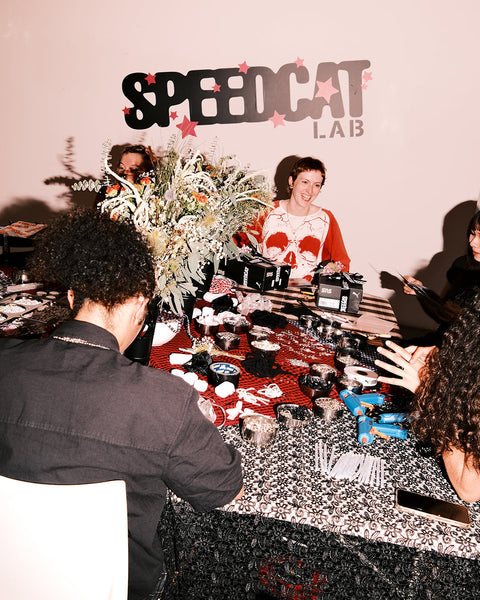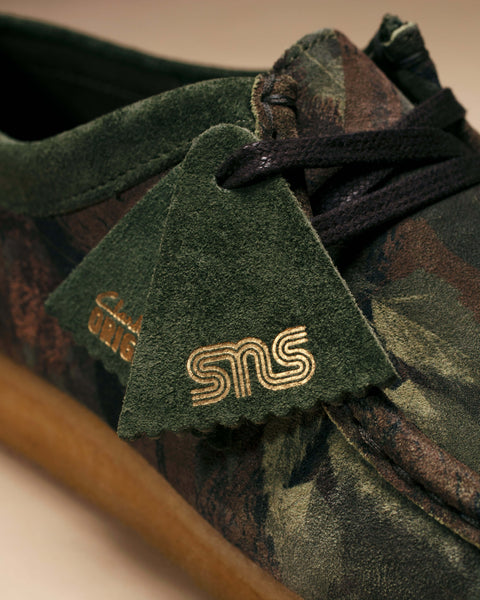
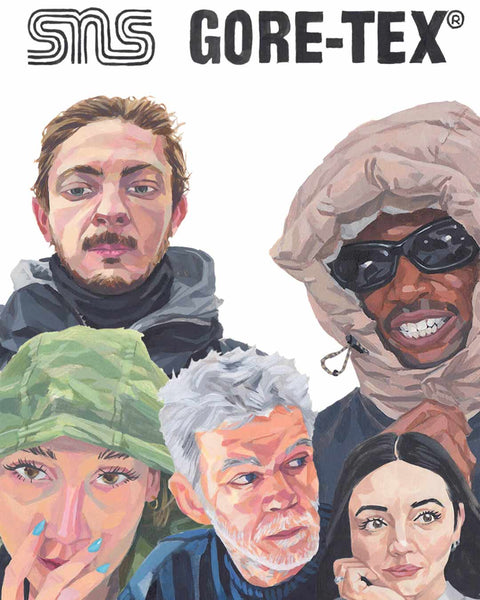
A deep dive into GORE-TEX®
An editorial project by Document Studios for SNS
Take one part New York City, add a chunk of the 1990s and sprinkle it with GORE-TEX. I bet what happens next is one of two things: either you recall a music video or a specific lyric from one of many possible hip hop artists working out of Brooklyn at that time, or you think of George Costanza and that coat.
For me, it’s all about Georgie.
Seminal Seinfeld episode ‘The Dinner Party’ was aired in February 1994, set in a freezing cold Manhattan, and features George in a massive winter coat, hardly able to move through doors because of its comedic size. In the episode George only explains the coat with “It’s GORE-TEX” when questioned about it by Jerry and Elaine. That was enough, no other facts – not even the brand name – was information deemed necessary. Fiction though it might be, I can’t think of any other pop-cultural seal of approval of that calibre.
I would have watched that episode in rural Sweden, probably a couple of years after it was originally aired, and though I can’t be 100% sure, it was most likely my first interaction with GORE-TEX. And the fact that the fabric technology has such pop-cultural reach is the entire point of this project. There are no doubts about GORE-TEX’s technological accomplishments, its popularity among global brands needing waterproof and windproof capabilities and the trust it enjoys among the end consumer – and this piece celebrates that aspect of GORE-TEX, too, through words of wisdom from various designers working with the technology – but it’s that name recognition and that ability to instil immediate confidence that transforms the GORE-TEX logo into a badge of honour.
Since watching that Seinfeld episode my own relationship with GORE-TEX has evolved and not long after that – thanks to the wet and windy climate in Scandinavia – it was centred around getting weather-appropriate gear rather than what George Costanza was able to buy from his father’s friend, at discounted prices. Nevertheless, my affection for GORE-TEX is still based on those two wardrobe pillars: technological quality and pop-cultural prowess. And it appears to be same but different for other as well, as attested to by this mixed bunch of young gun talent, established design icons, birdwatching hikers and graffiti artists. Hope you enjoy this deep dive into what GORE-TEX means to different people, both personally and professionally.
Text by David Hellqvist / Document Studios
Illustrations by Gangbox
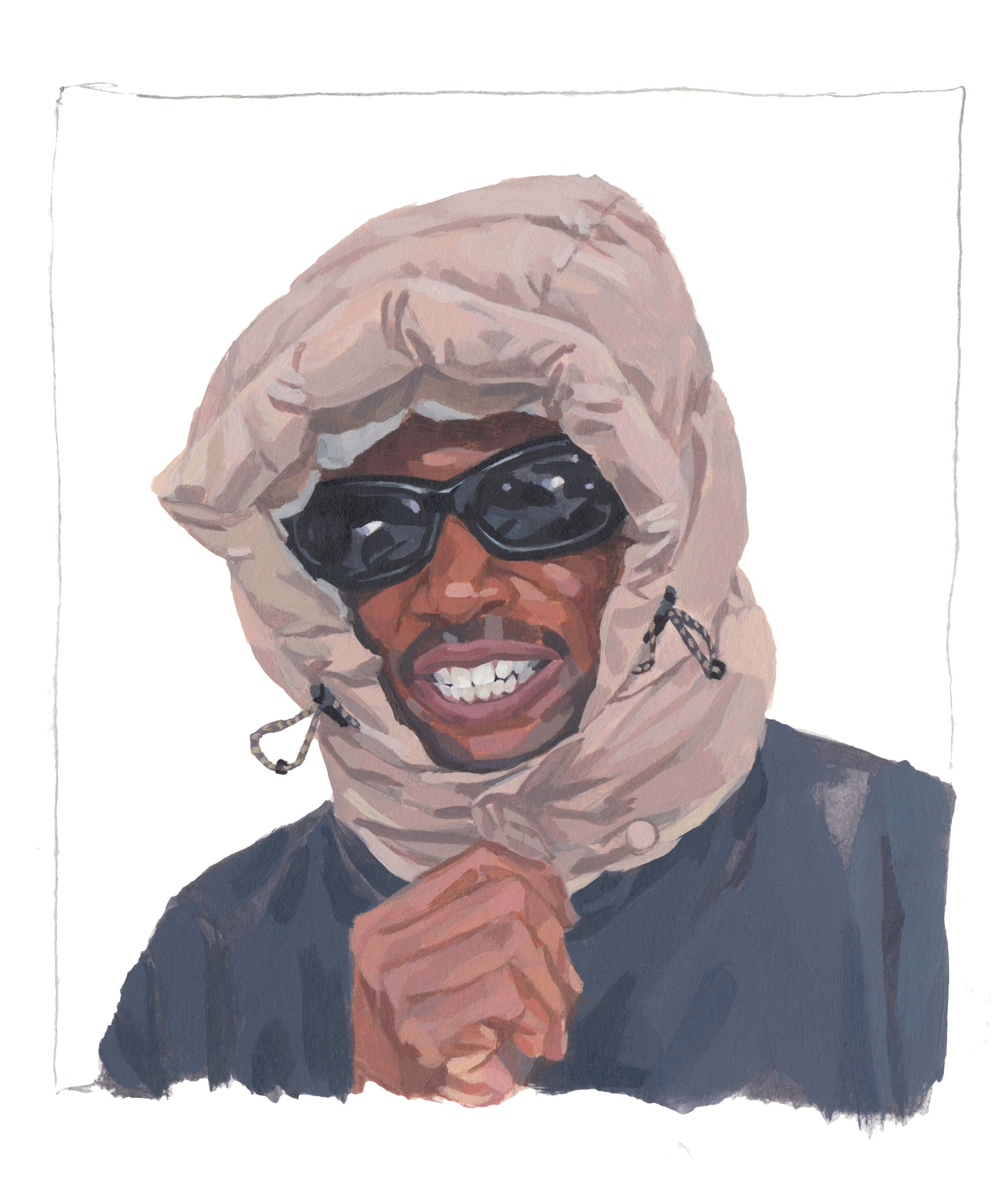
Ollie Olanipekun
"GORE-TEX is now being recognised as a fundamental material”
In May 2020 Ollie conceived Flock Together. Alongside Nadeem Perara and a small team they deliver a monthly support club combatting the underrepresentation of black, brown and POC in nature. Originating in east London, there are now international Flock Together hikes, a Fila collab collection and the first FT book, ‘Outsiders’, is out later this year.
Can you remember the first time you heard about GORE-TEX, when and where was that?
Ollie : I think the first time I heard anyone really talking about GORE-TEX on a cultural level would have been around 2007 and it would have been through either Jörg Haas at BeingHunted or Gary Warnett (RIP). But I would have first been introduced to GORE-TEX through Berghaus when they were the jackets to have in secondary school, this must have been around 1998. Growing up in the Midlands we were influenced by London as well as the North and the Northerners really know their outerwear with all that grim weather.
GORE-TEX is very much interlinked with functionality - what role does functionality and purpose play in your wardrobe?
Ollie : My wardrobe is very functional, I'm probably quite OCD in regards to ensuring I've got the right gear for the activity. For as long as I can remember I've been fascinated with jackets and how they're constructed. The development over the years has been amazing to see, from the water proofing through seam technology and all the hood systems.
Have you ever come across GORE-TEX in another cultural expression, such as music or art?
Ollie : Of course, in music. Growing up in the 90s I used to love seeing the coats and jackets worn by New York artists of the time. Helly Hansen and The North Face jackets were staples. At the time I probably wasn't aware of GORE-TEX’s specific role in the making of those pieces, though. I wasn't ever into Brit Pop but they definitely contributed to the style crossover waterproof jackets had.
How do you think GORE-TEX is seen culturally, as in beyond its pure technical qualities?
Ollie : With the popularity of outdoor activities, and the gear that comes with it, I think GORE-TEX is now being recognised a lot more as a fundamental material. I believe there is still work to be done for it to be seen as more than just a technology. The problem it faces is that the brand using GORE-TEX will a lot of time be referenced before the material.
When you’re out with Flock Together, how important is it to test yourself and your gear against weather conditions?
Ollie : As a leader of the group, it’s essential for us to test ourselves and our gear to avoid any problems on the walk. The safeguarding that goes into outdoor activities is very important alongside being a good influence to all the beginners that attend our walks. For many the Flock Together walks are their first time experiencing outdoor activities in this way so there's a duty to educate.
Can you think of a particular day out that completely rained away and where GORE-TEX helped make a difference?
Ollie : My Burton AK with its triple layer GORE-TEX, which I've had for well over 10 years, has saved me on numerous occasions. Last year, in the Lake District, we got caught out on a hike and this was one of the most severe storms I had ever experienced. The wind and the rain came down like crazy and I was so impressed with how the GORE-TEX jacket coped with the gale force winds, as well as keeping me dry. The wind protection is something you think about as secondary.
To you, what brands and why use GORE-TEX best?
Ollie : I think Stüssy has been great with its use of GORE-TEX because it brings in that element of personality. More variety in the silhouettes and great use of colour. I also was very impressed with how Paria Farzaneh used GORE-TEX and still created these amazing traditional patterns.
Any brands out there you’d think benefit from working with GORE-TEX?
Ollie : Birkenstock would be a great brand to get the GORE-TEX treatment. It’s a brand that has so much potential, and I think GORE-TEX would make the footwear more “always on” versus your house shoe or only a product for dry months.
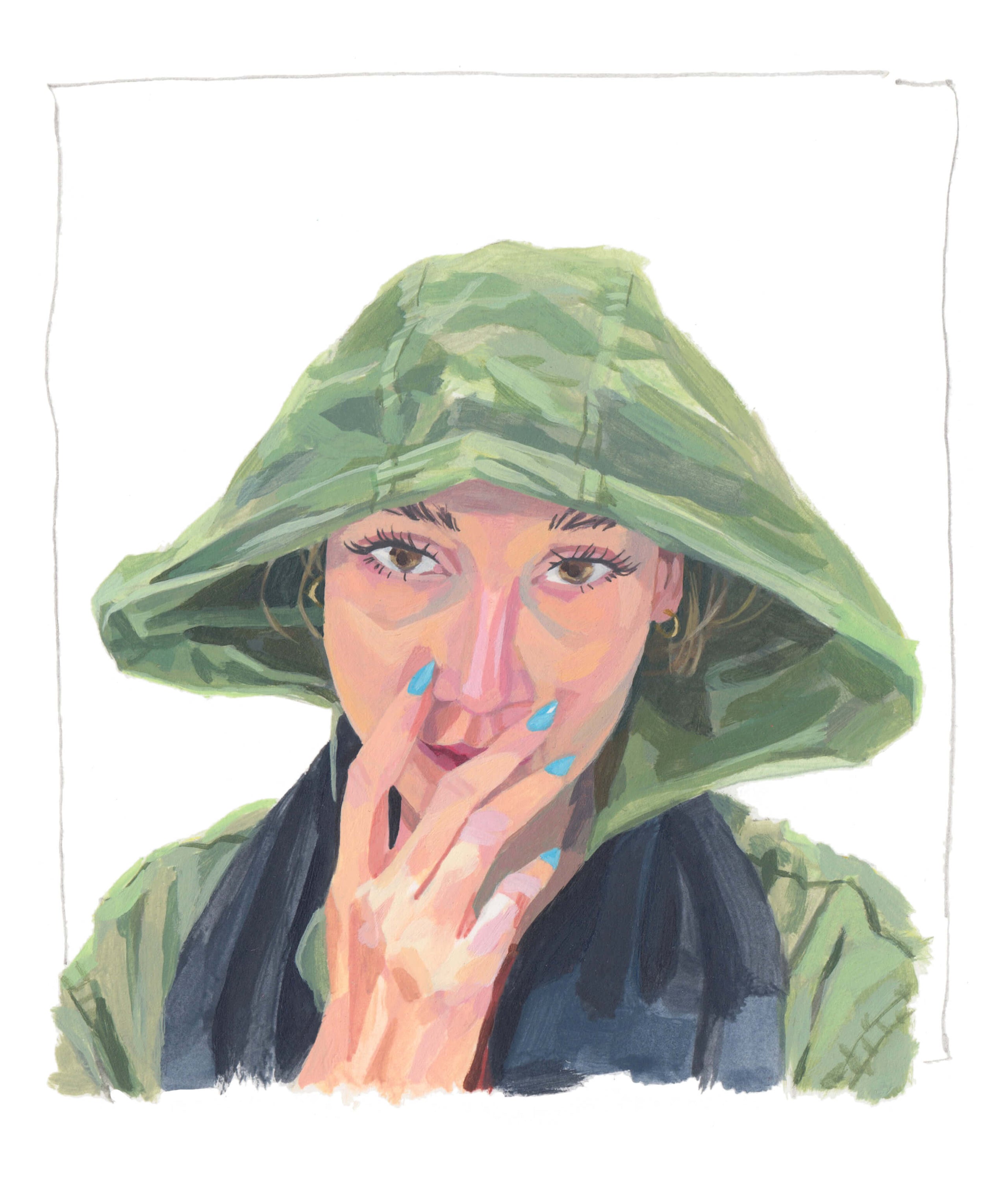
Bonnie Carr
"The standardisation of garment technology”
Bonnie is a design consultant, outerwear connoisseur, writer and founder of Not For Archiving, an IG-based knowledge bank for technical sportswear where Bonnie takes apart garments to structurally and culturally contextualise them.
When was the first time you heard about GORE-TEX?
Bonnie : I was a kid obsessed with bikes and how things work. I can remember the dude who would help me with an old BMX I was given, aged six or seven maybe? He wore a GORE-TEX jacket. This wasn't the point of me becoming more aware of technical functionality. This came a few years after, on seeing Moreno's Urban Protection range for C.P. and wondering how it was all assembled as a super curious near-teen.
Can you remember which garment the BMX guy wore?
Bonnie : I can yeah haha, it was a Berghaus Gore, similar to what Berg continues to make these days. A classic. Just as an aside, this was also the first time my brain logged outdoors brands being worn by people I saw as cool and interesting. You know, those I could learn from, basically.
Have you ever come across GORE-TEX in other cultural expressions?
Bonnie : It seeps into music and now art for sure. Have you seen Karel Funk's work? It's so cool man. I think this whole reappropriation thing is where GORE-TEX becomes a cultural expression and a brand in its own right - even the name itself is part of this cross-over. Gore, it’s a weighty, magnetic sounding name, no? And this has a tangible part to play in its ability to be interesting to different social demographics. I mean, just google GORE-TEX in lyrics. It's referenced a lot these days and represents an ultimate standard, GORE-TEX taking the role of urban guardian now, as well as the protector halfway up a Swiss mountain. It has become strong imagery over the last few years. Changing from something protective and safe to something defensive and volatile. This is the transition I love so much when the immaculate falls into the hands of the disgruntled or sub-culturally motivated. I mean it doesn't even 'fall' it’s taken, swiped, grabbed at by the 'underclasses'.
How do you think GORE-TEX is seen culturally, as in beyond its pure technical qualities?
Bonnie : It’s seen as the benchmark for quality. Over time it's become a hack for people to display clout. For example, you buy monogram Fendi for its obvious association, right? Anyone coming down the road will clock your expensive trousers. It's the same currently for the GORE-TEX Infinium logo. Like I would notice that on a jacket and appreciate its value. So perhaps what we are witnessing is the appreciation of technical materials in the same way we would appreciate silk or other incredibly expensive fabrics. Whether it says Gucci or GORE-TEX now, it's being judged within the same arena.
How would you describe and define GORE-TEX?
Bonnie : I would describe GORE-TEX as the standardisation of garment technology. A benchmark. It's important now more than ever as not only do we need functional materials more, a genuine need, as everyday climates and pollutants change. It has also become a cultural mirror- as some fabrics do, fur for example. The reflection of unrest, of defensiveness, of covert manoeuvrability, a Covid reminder, a physical thing that joins and separates socially, in equal measure.
Any moments you can think of when GORE-TEX technology saved your day?
Bonnie : Honestly? Recently, only from downpours or my dog being an idiot in the forest. I could not and would not pretend to be hanging about on icy precipices in environmental danger haha. But, I will say it's probably kept me safe in the city at night more times than I'm aware of. Being a female and moving around in a genderless black swath of GORE-TEX, synched, face covered is extremely empowering and although culturally dark, gives me the ability to appear unassailable, as who or what I am is 90% unknown. So you know what? Yes, GORE-TEX has probably saved me from some sticky dimly lit situations. As a woman living alone in East London, this is invaluable.
What brands impress you in their use of GORE-TEX?
Bonnie : I like what Goldwin's Japan team do, I'm also into C.P. Company re-looking at the Metropolis Series as a future-facing piece for 2022 and beyond and I like Veilance's simple implementation. But, in my opinion, no-one is catching up with Stone Island’s fabric development over the decades. I can't even see how it's possible to remove Massimo Osti from that throne and I certainly wouldn't want to. So actually, let's celebrate the masters of material development and not always look to the 'new' for better implementation and usage.
How do you see GORE-TEX’s role in footwear develop?
Bonnie : I think GORE-TEX is incredibly robust in footwear. It blocks weather impact, protects from cold air, whilst warming and shielding the foot, we know this right? I do wonder how the evolution of excellent sports brands like Norda will change the future path of technical materials in sport-specific footwear. Their development in the area of Bio-Dyneema running shoes for example, could really be persuasive at a level far wider than runners and trail lovers alone.
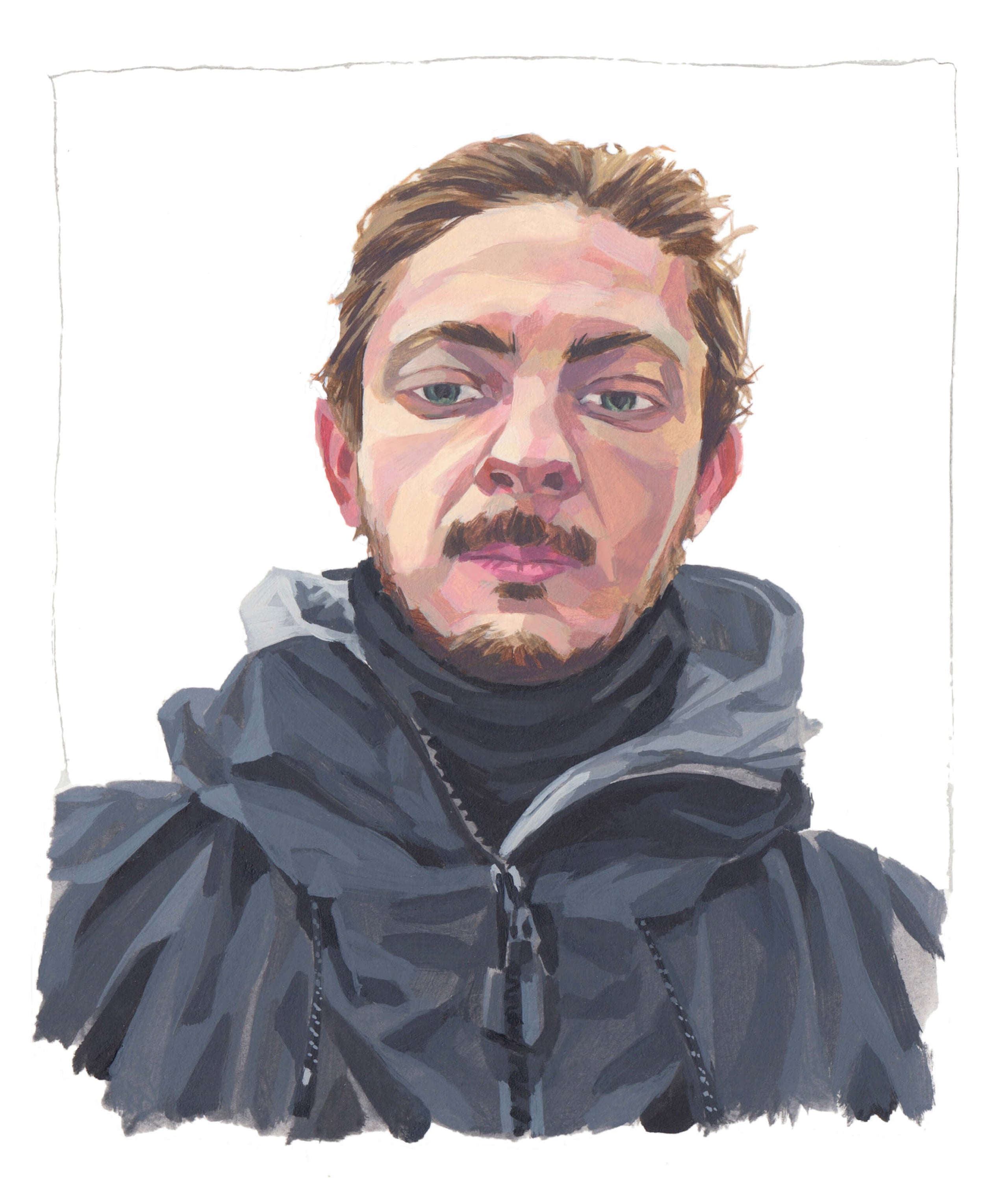
Robert Newman
“GORE-TEX is a gold standard, an emblem of being serious"
After graduating from his Westminster University MA in 2018, Robert have added a short but powerful ‘Who’s Who in Menswear’ list of employers to his CV. Having worked with C.P. Company and Maharishi straight out of Uni, today the Glasgow-based designer consults for Supreme and Stone Island and is preparing to launch his own brand, Middle Distance.
Can you remember the first time you heard about GORE-TEX?
Robert: I grew up in the West Country, in southwestern England, going to steam fairs with my dad where the uniform was a lot of military surplus GORE-TEX. Later on, I spent a lot of time cycling around to visit stone circles in the rain and at the point, when I started to have my own money, I bought a completely knackered US Army GORE-TEX desert Camo ECWCS parka from Marcruss, an army surplus in Bristol.
When did you start working with GORE-TEX professionally?
Robert : Probably only in the last three or four years, since I’ve begun to work with bigger brands. It’s always been a staple of a lot of the companies I’ve worked with, both for its function but also its talismanic value; it comes with a whole history and mythology that goes back to around the same time as the groundwork for this new thing called streetwear was being laid. I very much see my work as part of that lineage, so working with those fabrics has been a privilege.
GORE-TEX is very much interlinked with functionality - what role does functionality and purpose play in your work?
Robert : It’s kind of two sides of the same coin. About six years ago I started doing a design masters in London whilst living in Glasgow. I went through a year of being basically a full time nomadic, never in the same place for more than three days at most, sleeping on overnight trains or on people’s floors etc. It was a nightmare but also a pretty defining point for my work, basically living out of a bag with very few garments in rotation; I think it was the first point where I realised that garments should work hard. My design as it stands is pretty much half about this kind of super functionality that was necessary during that time, and then the other half on this more fantastical, speculative side that tells a story.
What role does it play in your own wardrobe?
Robert : I live full time in Scotland now, and love to hike and camp, so it’s pretty crucial as it rains constantly. I’ve been wearing and repairing the same simple Rab GORE-TEX Pro shell for the last few years, alongside a few Supreme GTX pieces on rotation and I’ve been in a pair of Arc’teryx Bora boots with the removable GORE-TEX sock since about 2016.
How do you think GORE-TEX is seen culturally, as in beyond its pure technical qualities?
Robert : It’s like a casual tuxedo, like an elevation above the rest. Talismanic, like I said before. I think, especially in menswear, people are looking for the closest thing to the spider man outfit they wore as a kid, but paradoxically, without sticking out too much. For some people that was always a handmade tailored suit that looked like the same one as the person next to you, but you know yours is made by artisans on Savile Row. But increasingly it's a full Arc ensemble in GORE-TEX Pro … to the untrained eye it’s a similar silhouette to some shit from Sports Direct with a hood, cinch waist, Velcro cuffs, ‘waterproof’ fabric, but you know that if the sky was to open, you’d be the one making it out alive.
Working between streetwear and experimental sportswear brands, where would you say GORE-TEX sits within each?
Robert : At the centre of the streetwear world, you have a kid who knows the cultural history of GORE-TEX inside out, in the mix with other fashion, and interlinking with art and music. They grew up knowing Wu-Tang were wearing GORE-TEX versions of the Ralph Lauren snow beach pullover, and this is the world they see themselves as part of, a lineage. GORE-TEX is then a kind of gold standard, an emblem of being serious, clued in, and part of a long history. A brand such as Stone Island is a self-enclosed world of experimentation and design language that’s been added to over the years like some vast civil engineering project. If the base line is a GORE-TEX shell, the Stone Island answer to that question is always an experiment-based on treatment of a fabric and a particular design language and its evolution.
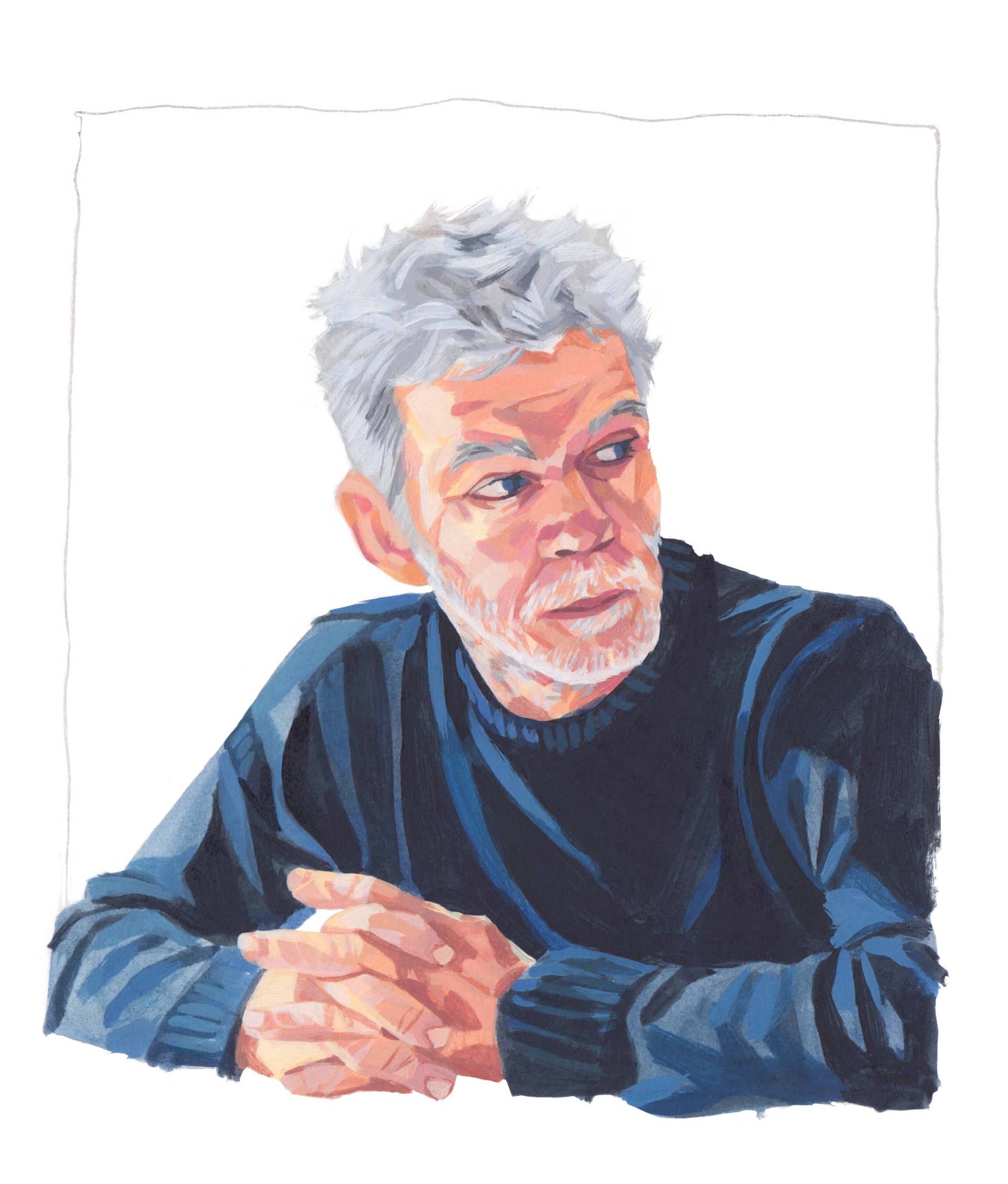
Paul Harvey
"The benchmark for waterproof fabrics”
Paul is the head designer of C.P. Company. together with Alessandro Pungetti. He moved to Italy having studied design at Central Saint Martins and has since helped define what Italian sportswear means today through his work with Sabotage, TEN C, Stone Island and now, C.P. Company. Even if you don’t own a garment from any of those brands you will have jackets in your wardrobe indirectly in debt to Paul’s work.
Can you remember the first time you heard about GORE-TEX, when and where was that?
Paul : Quite literally last century. I think about 1980, the first time I ever went skiing. I bought a The North Face shell, which I still have. And still use, for that matter. Before that, back in England, if you wanted a waterproof jacket, you’d have to go either Barbour or Belstaff. I started working with GORE-TEX around 1988/9, I think. I designed the first three or four collections for Nordica when it was bought by Benetton.
GORE-TEX is very much interlinked with functionality - what role does functionality and purpose play in your work?
Paul : If you believe most of the press releases/interviews, it is the god by which I live. But that’s not true, pure functionality would be very boring indeed. There would be no need for ‘fashion designers’. But I do believe things should work and have always tried to avoid unnecessary add-ons. So, if a jacket, a pair of trousers or a bag has principally to be waterproof, GORE-TEX will always be one of the key contenders. But by no means the only one.
What role does it play in your own wardrobe?
Paul : GORE-TEX or functionality? GORE-TEX surprisingly very little but that’s because I’m lucky enough to live in Italy and rain is really not much of a problem in these parts. When I do get to go skiing though, I still have my 1980s The North Face GORE-TEX shell and an early 1990s Arc’teryx GORE-TEX jacket, one of the first pieces they ever made. They are both still perfect as the outer layer. Functionality? Strangely, in a big, big way. I’m like the pizza cook who never eats pizza. I have a no-nonsense, very, very boring wardrobe of exactly the same pieces that I put on every day and never even think about it. Very, very functional.
How do you define the term ‘comfort’ in clothing, in particular technical apparel?
Paul : Comfort psychologically or physically? Psychologically I’m comfortable in my jeans and
T-shirt as maybe someone from the City [London’s financial district] is comfortable in a suit. Physically someone could feel psychologically comfortable in a GORE-TEX garment because they know they are not going to get wet. ‘Comfort’ means you feel good about how you are dressed. For a million different reasons.
What words would you use to describe GORE-TEX as a technology but also in terms of its relevance?
Paul : In a very pragmatic way, I find it really interesting. We have this super delicate membrane of ePTFE, which in an incredibly primitive way does what our skin does, it breathes and is waterproof. We can’t make anything from this membrane, it is too delicate, so we must protect it on the outside from abrasion and on the inside from a different type of abrasion. And when we sew it, we make holes in it which don’t ‘heal’, so we have to tape it to close the holes. “A consequence of our evolution?” Undoubtably two- or three-layer fabrics, pioneered by GORE-TEX, have become the benchmark for waterproof fabrics.
Any moments you can think of when GORE-TEX technology saved your day?
Paul : Yep. The last time Alessandro and I were in Tokyo for a lightning C.P. Company shop tour the weather was appalling, an emergency-bought GORE-TEX jacket saved the trip. But professionally, GORE-TEX technology really made my day three or four months ago: for the C.P. Company AW22 collection we showed a garment-dyed GORE-TEX shell jacket with detachable lining and the colours that came out due to the three-layer technology, the taping and the garment dyeing process were simply unbelievable.

Robyn Lynch
“The importance of breathable fabrics in technical apparel is vital”
The Dublin-born menswear designer founded her brand upon graduating from the Menswear MA at the University of Westminster in 2018. Now based in London, Robyn shows her eponymous brand at London Fashion Week, and has an ongoing outdoors-inspired partnership with Columbia. Robyn’s work beautifully balances her interest in technical outerwear with her strong Irish cultural roots.
Can you remember the first time you heard about GORE-TEX, when and where was that?
Robyn : I think the first time I heard about GORE-TEX was while I was studying for my MA. I tended to have a lot of interest in fabrication development and fibres, which stemmed from my time studying Textiles on my BA. We were taught about the compounds that make up different types of fabrics so I naturally had an interest in this. I really started to research more into technical outerwear fabrics when I chose to specialise in Menswear on my MA. This was back in 2017
When and why did you start working with GORE-TEX professionally?
Robyn : That would have been when I worked on a capsule collection project with cyclewear brand Rapha. In 2020 we teamed up to make a small 10-piece collection of upcycled garments from a donation of deadstock and old samples. This was when I really got to work with the fabrication, unpicking the garments to construct them into a new product really allows you to see all the different layers and components that go into making these technical garments. We used different types of GORE-TEX, some fabrics with the thin membrane and others with the laminated coating.
How do you define the term ‘comfort’ in clothing, in particular technical apparel?
Robyn : I think comfort is important in both fabrication and temperature regulation. The importance of breathable fabrics in technical apparel is vital and the softness against your skin. For AW20 we developed our own attempt at achieving this balance. We took a regular outerwear rib stock fabric from Portugal and bonded it with a thin layer of fusible needle foam fabric from the UK. It changed the weight of the fabric completely and made the nylon extremely durable whilst also being comfortable against the skin. It also made the traditional tracksuit bottom suitable for the coldest conditions in perfect timing for when the world was turned upside down due to Covid and being outdoors was the main source of socialising.
Have you ever come across GORE-TEX in another cultural expression?
Robyn : Does Instagram memes and TikTok count? I think as it is so popular now in my generation and Gen Z it's only normal that it also comes under crossfire with humour. I have seen a lot of very funny memes that stereotype the consumer of GORE-TEX.
If so, how do you think GORE-TEX is seen culturally, as in beyond its pure technical qualities?
Robyn : It has its hype following but also a lot of very loyal followers who have been wearing it for a very long time. I don't know if this hyped culture is accepted well with its loyal day one followers, however. I think the rise of its popularity has to do with many factors, but I think honestly Covid has a big role to play. Like I said above, the need to socialise outdoors over the past two years has become fundamental and people need a new form of entertainment. I think hiking and being in the great outdoors took centre stage. I’d also argue the way consumers shop and think is changing. I think the future generations are becoming more aware of sustainability through fashion and learning more about technical fabrics that have a long lifeline instead of traditionally shopping fast fashion.
------------------------
